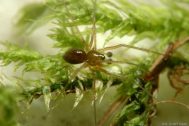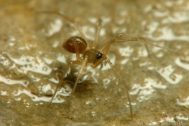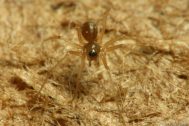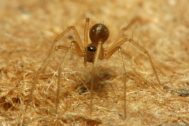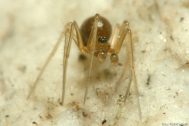Kvadráty: 5643 6370 5352 5152 5663 6666 5349 7351 5350 6847 6048 6050 5252 6252 5153 5449 6448 5448 6149 6846 6845 6152 5253 5260 7152 5255 5949 6946 6049 5450 5258
| Nálezy podle období | |||||
|---|---|---|---|---|---|
| Linyphiidae | 0-1900 | 1901-1950 | 1951-2000 | 2001+ | ∑ |
| Lepthyphantes notabilis Kulczyński, 1887 Není ohrožený | 112× | 3× | 115× | ||
Lepthyphantes notabilis Kulczyński, 1887
| České jméno | plachetnatka dýkovitá |
|---|---|
| Stupeň ohrožení | Není ohrožený |
| Nálezy | 115 nálezů, 31 kvadrátů |
| První nález |
1971, F. Miller, Miller 1971 |
| Poslední nález | 2023 , Antonín Roušar |
| Areál rozšíření | European - ME |
| Fytogeografická oblast |
|
| Původnost stanovišť |
|
| Vlhkost stanovišť |
|
| Stratum |
|
| Osvětlení stanovišť |
|
| Hojnost výskytu |
|
| Nadm. výška | 250-1400 |
Literatura
Pavouk 38 (7/2015)
Méně známé druhy pavouků – Frontinellina frutetorum; Pirata von Noldenteich; Křižák Neoscona adianta za humny!; Ještě Porrhomma; Jak je to s původem křižáka Argiope bruennichi v Česku?; Rytířský souboj; Arachnologická exkurze – jižní Morava 2015; Ocenění arachnologové; Aktualizace rolí v České arachnologické společnosti; Konference; Česká bibliografie; Britská bibliografie; Inventarizace 2014Spider (Araneae) communities of scree slopes in the Czech Republic
We assessed the effects of environmental factors on spider communities in screes (sloping mass of coarse rock fragments) of the Czech Republic, based on catches from 325 pitfall traps, exposed for 177–670 days, from 1984–2000. Bootstrap resampling was applied to test for fuzziness of the partitions in cluster analysis of the samples. Two distinct spider communities were identified. The first one was confined to sites where ice is formed and persists until late summer or over the whole year. This community consists of numerous relict spiders, such as Bathyphantes simillimus buchari Růžička 1988, Diplocentria bidentata (Emerton 1882) and Lepthyphantes tripartitus Miller & Svatoň 1978, possibly persisting in these cold screes from the early postglacial period. The other community included all other sites, irrespective of their environmental characteristics. Monte Carlo simulations were used to test the significance of environmental factors and their interactions on the studied communities. Ice formation near the traps and position of the traps within individual screes were the most significant factors, followed by the depth of the traps within the scree, diameter of stones forming the scree, and altitude. A marginally significant effect was found for organic content in the scree matter, whereas presence of trees and phytogeographical districts appeared non-significant. Our analyses support the view that spiders inhabiting cold screes in Central Europe belong to a unique relict community of species requiring cold and stable microclimate.On the lithobionts Lepthyphantes notabilis , Rugathodes bellicosus and on Rugathodes instabilis (Araneae: Linyphiidae, Theridiidae)
Data have been gathered on the distribution of the species Lepthyphantes notabilis Kulcz., 1887, Rugathodes bellicosus (Simon, 1873), and Rugathodes instabilis (O. P.-Cbr., 1870) in the Czechoslovakia. The general geographical distribution of these species is also presented and the individual ecological demands of each species are specified. The influence of altitude on body size and coloration in Rugathodes bellicosus is discussed.Fotografie
Statistiky
Dle měsíce v roce
Dle nadmořské výšky
Dle metody sběru (115 použitých nálezů)
| Lepthyphantes notabilis Kulczyński, 1887 ES | Samci | Samice | Mláďata | Nálezy |
|---|---|---|---|---|
| Individuální sběr | 11 | 34 | 0 | 15 |
| Zemní past | 187 | 192 | 1 | 88 |
| Neurčeno | 3 | 12 | 0 | 11 |
| Sklepávání | 0 | 1 | 0 | 1 |
| Samci | Samice | Mláďata | Nálezy |
Dle biotopu (115 použitých nálezů)
| Lepthyphantes notabilis Kulczyński, 1887 ES | Samci | Samice | Mláďata | Nálezy |
|---|---|---|---|---|
| Skály a sutě v horách | 1 | 3 | 0 | 1 |
| Neurčeno | 13 | 17 | 0 | 13 |
| Kamenité suti nižších poloh | 183 | 205 | 1 | 90 |
| Lesy vyšších poloh a strmých svahů | 4 | 10 | 0 | 7 |
| Lužní lesy nížin | 0 | 1 | 0 | 1 |
| Suťové a roklinové lesy | 0 | 2 | 0 | 2 |
| Lesní okraje | 0 | 1 | 0 | 1 |
| Samci | Samice | Mláďata | Nálezy |





